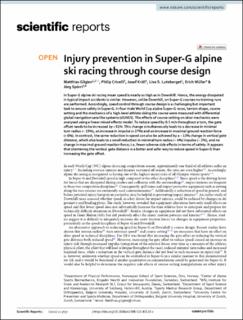| dc.contributor.author | Gilgien, Matthias | |
| dc.contributor.author | Crivelli, Philip | |
| dc.contributor.author | Kröll, Josef | |
| dc.contributor.author | Müller, Erich | |
| dc.contributor.author | Spörri, Jörg | |
| dc.contributor.author | Luteberget, Live | |
| dc.date.accessioned | 2021-09-22T15:41:53Z | |
| dc.date.available | 2021-09-22T15:41:53Z | |
| dc.date.created | 2021-06-17T14:41:29Z | |
| dc.date.issued | 2021 | |
| dc.identifier.citation | Scientific Reports. 2021, 11(2021), Artikkel 3637. | en_US |
| dc.identifier.issn | 2045-2322 | |
| dc.identifier.uri | https://hdl.handle.net/11250/2780434 | |
| dc.description | This article is licensed under a Creative Commons Attribution 4.0 International License, which permits use, sharing, adaptation, distribution and reproduction in any medium or format, as long as you give appropriate credit to the original author(s) and the source, provide a link to the Creative Commons licence, and indicate if changes were made. The images or other third party material in this article are included in the article’s Creative Commons licence, unless indicated otherwise in a credit line to the material. If material is not included in the article’s Creative Commons licence and your intended use is not permitted by statutory regulation or exceeds the permitted use, you will need to obtain permission directly from the copyright holder. | en_US |
| dc.description.abstract | In Super-G alpine ski racing mean speed is nearly as high as in Downhill. Hence, the energy dissipated in typical impact accidents is similar. However, unlike Downhill, on Super-G courses no training runs are performed. Accordingly, speed control through course design is a challenging but important task to ensure safety in Super-G. In four male World Cup alpine Super-G races, terrain shape, course setting and the mechanics of a high-level athlete skiing the course were measured with differential global navigation satellite systems (dGNSS). The effects of course setting on skier mechanics were analysed using a linear mixed effects model. To reduce speed by 0.5 m/s throughout a turn, the gate offset needs to be increased by + 51%. This change simultaneously leads to a decrease in minimal turn radius (− 19%), an increase in impulse (+ 27%) and an increase in maximal ground reaction force (+ 6%). In contrast, the same reduction in speed can also be achieved by a − 13% change in vertical gate distance, which also leads to a small reduction in minimal turn radius (− 4%) impulse (− 2%), and no change in maximal ground reaction force; i.e. fewer adverse side effects in terms of safety. It appears that shortening the vertical gate distance is a better and safer way to reduce speed in Super-G than increasing the gate offset. | en_US |
| dc.language.iso | eng | en_US |
| dc.subject | engineering | en_US |
| dc.subject | mathematics and computing | en_US |
| dc.subject | physics | en_US |
| dc.subject | risk factors | en_US |
| dc.title | Injury prevention in Super-G alpine ski racing through course design | en_US |
| dc.type | Peer reviewed | en_US |
| dc.type | Journal article | en_US |
| dc.description.version | publishedVersion | en_US |
| dc.rights.holder | © The Author(s) 2021 | en_US |
| dc.source.pagenumber | 7 | en_US |
| dc.source.volume | 11 | en_US |
| dc.source.journal | Scientific Reports | en_US |
| dc.identifier.doi | 10.1038/s41598-021-83133-z | |
| dc.identifier.cristin | 1916453 | |
| dc.description.localcode | Institutt for fysisk prestasjonsevne / Department of Physical Performance | en_US |
| dc.source.articlenumber | 3637 | en_US |
| cristin.ispublished | true | |
| cristin.fulltext | original | |
| cristin.qualitycode | 1 | |
